Paper Menu >>
Journal Menu >>
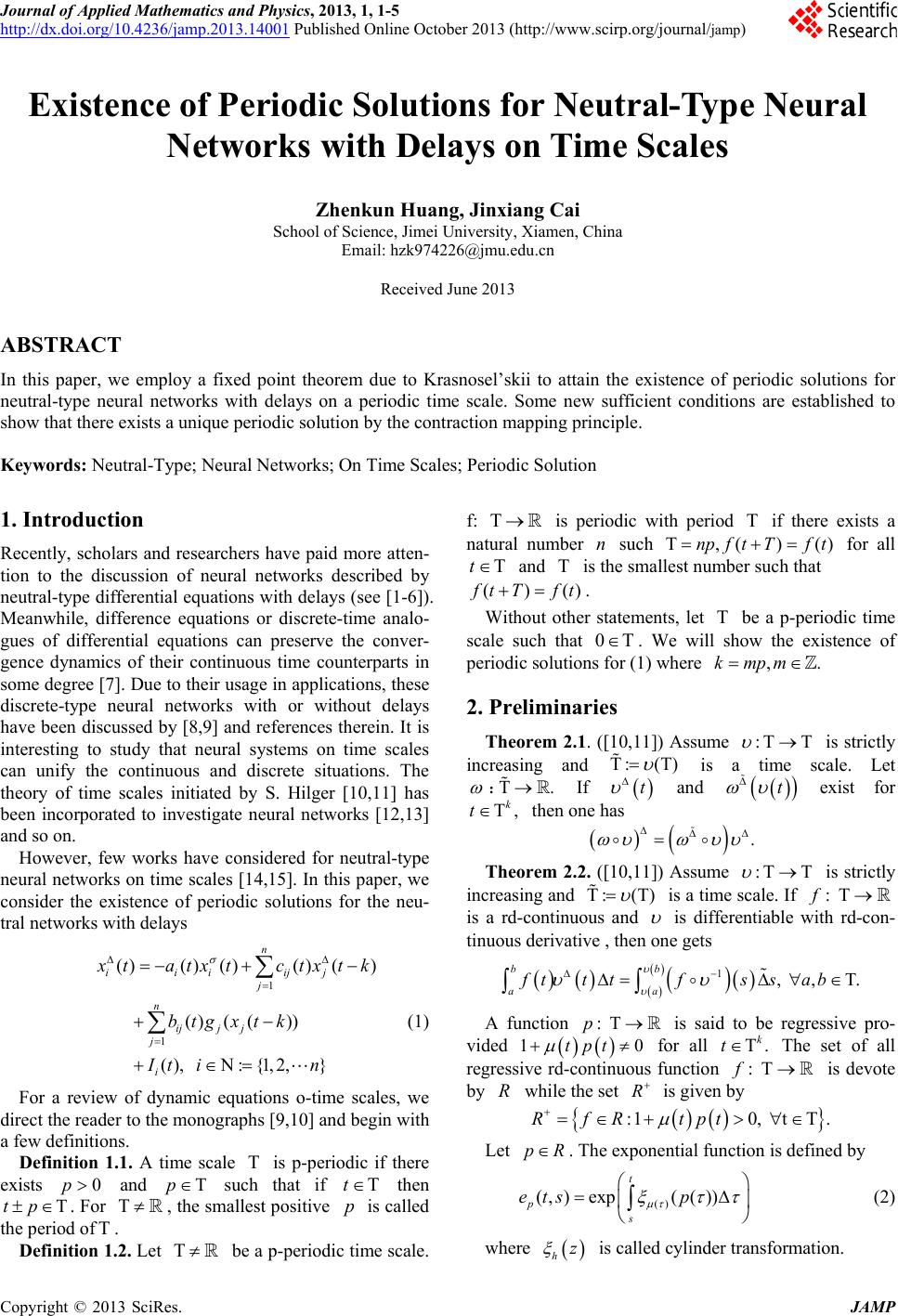 Journal of Applied Mathematics and Physics, 2013, 1, 1-5 http://dx.doi.org/10.4236/jamp.2013.14001 Published Online October 2013 (http://www.scirp.org/journal/jamp) Copyright © 2013 SciRes. JAMP Existence of Periodic Solutions for Neutral-Type Neural Networks with Delays on Time Scales Zhenkun Huang, Jinxiang Cai School of Science, Jimei University, Xiamen, China Email: hzk974226@jmu.edu.cn Received June 2013 ABSTRACT In this paper, we employ a fixed point theorem due to Krasnosel’skii to attain the existence of periodic solutions for neutral-type neural networks with delays on a periodic time scale. Some new sufficient conditions are established to show that there exists a unique periodic solution by the contraction mapping principle. Keywords: Neutral-Type; Neural Networks; On Time Scales; Periodic Solution 1. Introduction Recently, scholars and researchers have paid more atten- tion to the discussion of neural networks described by neutral-type differential equations with delays (see [1-6]). Meanwhile, difference equations or discrete-time analo- gues of differential equations can preserve the conver- gence dynamics of their continuous time counterparts in some degree [7]. Due to their usage in applications, these discrete-type neural networks with or without delays have been discussed by [8,9] and references therein. It is interesting to study that neural systems on time scales can unify the continuous and discrete situations. The theory of time scales initiated by S. Hilger [10,11] has been incorporated to investigate neural networks [12,13] and so on. However, few works have considered for neutral-type neural networks on time scales [14,15 ]. In this paper, we consider the existence of periodic solutions for the neu- tral networks with delays 1 1 ()()()() () ()(()) (), :{1,2,} n iii ijj j n ijj j j i x tatxtc txtk btgxt k It in (1) For a review of dynamic equations o-time scales, we direct the reader to the monographs [9,10] and begin with a few definitions. Definition 1.1. A time scale is p-periodic if there exists 0p and p such that if t then tp. For , the smallest positive p is called the period of. Definition 1.2. Let be a p-periodic time scale. f: is periodic with period if there exists a natural number n such ,() ()np f tTf t for all t and is the smallest number such that ()() f tT ft . Without other statements, let be a p-periodic time scale such that 0 . We will show the existence of periodic solutions for (1) where ,.kmpm 2. Preliminaries Theorem 2.1. ([10,11]) Assume : is strictly increasing and :() is a time scale. Let . : If t and t exist for , k t then one has . Theorem 2.2. ([10,11]) Assume : is strictly increasing and :() is a time scale. If : f is a rd-continuous and is differentiable with rd-con- tinuous derivative , then one gets 1, ,. bb aa ftt tfs sab A function : p is said to be regressive pro- vided 10tpt for all . k t The set of all regressive rd-continuous function : f is devote by R while the set R is given by :10, t.RfRtpt Let pR . The exponential function is defined by () (,)exp(( )) t ps ets p (2) where hz is called cylinder transformation. 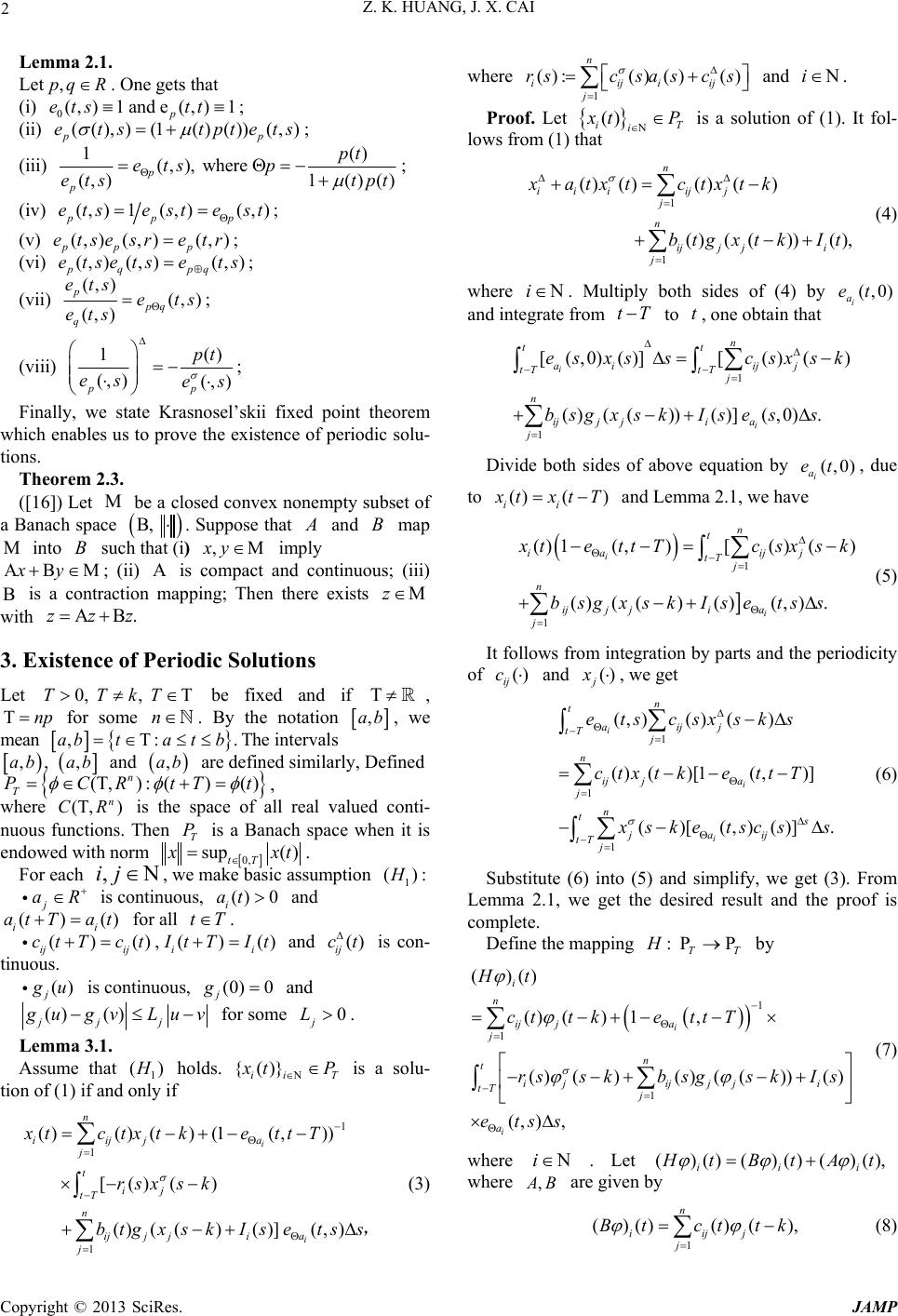 Z. K. HUANG, J. X. CAI Copyright © 2013 SciRes. JAMP 2 Lemma 2.1. Let ,pqR. One gets that (i) 0(,)1 and e(,)1 p ets tt; (ii) ((),)(1()())(,) pp ets tptets ; (iii) 1() (,), where (, )1()() p p pt ets p etstpt ; (iv) (, )1(,)(,) ppp etseste st ; (v) (,)(,)(,) pp p etsesr etr; (vi) (,)(,)(,) pq pq etsets ets ; (vii) (, )(, ) (,) ppq q ets ets ets ; (viii) 1() (, )(, ) pp pt es es ; Finally, we state Krasnosel’skii fixed point theorem which enables us to prov e the existence of period ic solu- tions. Theorem 2.3. ([16]) Let be a closed convex nonempty subset of a Banach space B, . Suppose that A and B map into B such that (i) ,xy imply xy; (ii) is compact and continuous; (iii) is a contraction mapping; Then there exists z with .zzz 3. Existence of Periodic Solutions Let 0, , TTkT be fixed and if , np for some n. By the notation ,ab, we mean ,:.abtatb The intervals ,, ,ab ab and ,ab are defined similarly, Defined (, ):()() n T P CR tTt , where (, ) n CR is the space of all real valued conti- nuous functions. Then T P is a Banach space when it is endowed with norm 0, sup( ) tT x xt . For each ,ij, we make basic assumption 1 () H : j aR is continuous, ()0 i at and ()() ii at Tat for all tT. ()(),()() ijij ii ctTct ItTIt and () ij ct is con- tinuous. () j g u is continuous, (0)0 j g and () () jj j g ugv Luv for some 0 j L. Lemma 3.1. Assume that 1 () H holds. {()} ii T x tP is a solu- tion of (1) if and only if 1 1 1 ()() () (1(,)) [()() ()(()()](, ) i i n iijja j t ij tT n ijj jia j xtc txtkettT rsx s k btgxskIsets s , (3) where 1 ():() ()() n iijiij j rsc sascs and i . Proof. Let () iT i x tP is a solution of (1). It fol- lows from (1) that 1 1 () ()() () ()(())(), n iiiijj j n ijj ji j xatxt ctxtk btgxt kIt (4) where i . Multiply both sides of (4) by (,0) i a et and integrate from tT to t, one obt a i n that 1 1 [(,0)()][()( ) ()( ())()](,0). i i n tt ai ijj tTtT j n ijj jia j es xsscsxsk bsgxskIse ss Divide both sides of above equation by (,0) i a et , due to ()() ii x txtT and Lemma 2.1, we have 1 1 ()1(,)[()() ()(()()(,). i i n t ia ijj tT j n ijj jia j x tettT csxsk bsgxsk Ise tss (5) It follows from integration by parts and the period icity of () ij c and () j x , we get 1 1 1 (, )()() () ()[1(,)] ()[(,)()]. i i i n t aijj tT j n ij ja j n ts jaij tTj etscsxsks ctxtke ttT x sketscss (6) Substitute (6) into (5) and simplify, we get (3). From Lemma 2.1, we get the desired result and the proof is complete. Define the mapping : PP TT H by 1 1 1 ()() () ()1, ()( )()(( ))() (,), i i i n ij ja j n t ijijjj i tT j a Ht cttke ttT rss kbsgskIs etss (7) where i . Let ()()()()()(), iii H tBtAt where ,AB are given by 1 ()()() (), n iijj j Bt cttk (8) 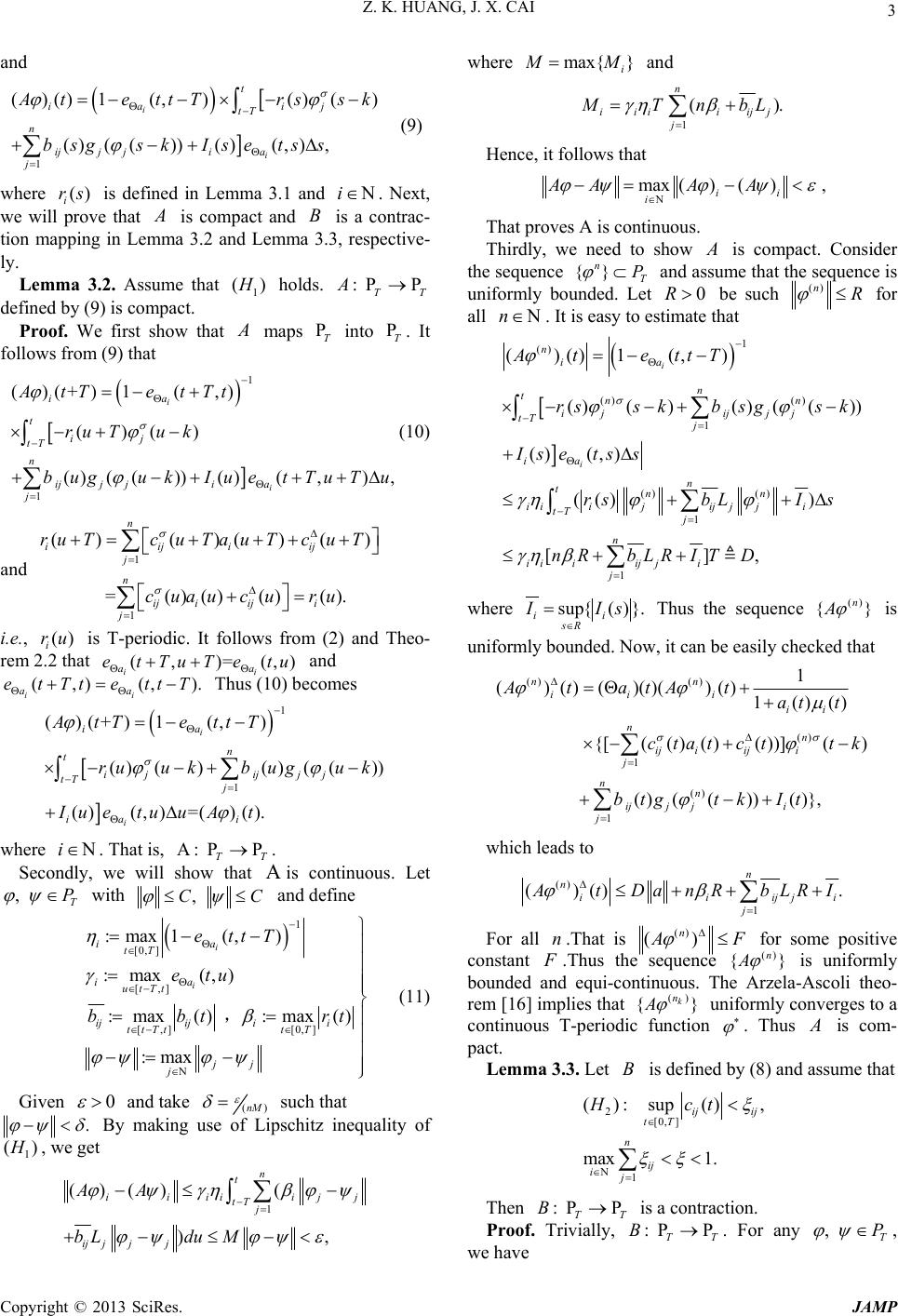 Z. K. HUANG, J. X. CAI Copyright © 2013 SciRes. JAMP 3 and 1 ()()1(,)()( ) () ( ())()(,), i i t ia ij tT n ijj jia j A tettT rssk bsgskIse tss (9) where () i rs is defined in Lemma 3.1 and i. Next, we will prove that A is compact and B is a contrac- tion mapping in Lemma 3.2 and Lemma 3.3, respective- ly. Lemma 3.2. Assume that 1 () H holds. : PP TT A defined by (9) is compact. Proof. We first show that A maps PT into PT. It follows from (9) that 1 1 ()(+)1( ,) ()() ()( ())()(,), i i ia t ij tT n ijj jia j AtT etTt ru Tuk bugukIuetTuT u (10) and 1 1 () ()()() =()()()(). n iijiij j n ij iiji j ruTcuTauT cuT cuau curu i.e., () i ru is T-periodic. It follows from (2) and Theo- rem 2.2 that (, )=(,) ii aa etTuTetu and (,)(,). ii aa etTtettT Thus (10) becomes 1 1 ()(+)1(, ) ()( )()(()) ()(,) =()(). i i ia n t ij ijjj tT j ia i AtT ettT ruukb uguk Iuetu uAt where i. That is, A: PP TT . Secondly, we will show that is continuous. Let , T P with , CC and define 1 [0,] [,] [,] [0,] :max1(, ) :max(,) :max() :max() :max i i ia tT ia utTt ijij ii ttTtt T jj j ettT etu bbt rt , (11) Given 0 and take ()nM such that . By making use of Lipschitz inequality of 1 () H , we get 1 ()() ( ), n t iiii ijj tTj ij jjj AA bLdu M where max{ } i M M and 1 (). n iii iijj j M TnbL Hence, it follows that max ()() ii i AAA A , That proves A is continuous. Thirdly, we need to show A is compact. Consider the sequence {} nT P and assume that the sequence is uniformly bounded. Let 0R be such ()nR for all n . It is easy to estimate that 1 () () () 1 () () 1 1 ()() 1(,) ()()()(( )) () (,) (() ) [], i i nia n tnn ij ijjj tT j ia n tnn iiijij jji tT j n iiiij ji j At ettT rss kbsgs k Isetss rsbLIs nRbLRIT D where sup{( )}. ii sR I Is Thus the sequence () {} n A is uniformly bounded. Now, it can be easily checked that () () () 1 () 1 1 ( )()()()( )()1()() {[(()()())]() ()(())()}, nn ii i ii nn ij iiji j nn ijj ji j AtatAtat t ctat cttk btgtk It which leads to () 1 ()(). n niiijji j A tDanRbLRI For all n.That is () () n A F for some positive constant F .Thus the sequence () {} n A is uniformly bounded and equi-continuous. The Arzela-Ascoli theo- rem [16] implies that () {} k n A uniformly co nverg es to a continuous T-periodic function . Thus A is com- pact. Lemma 3.3. Let B is defined by (8) and assume that 2[0,] 1 (): sup(), max 1. ij ij tT n ij ij Hct Then : PP TT B is a contraction. Proof. Trivially, : PP TT B. For any , T P , we have 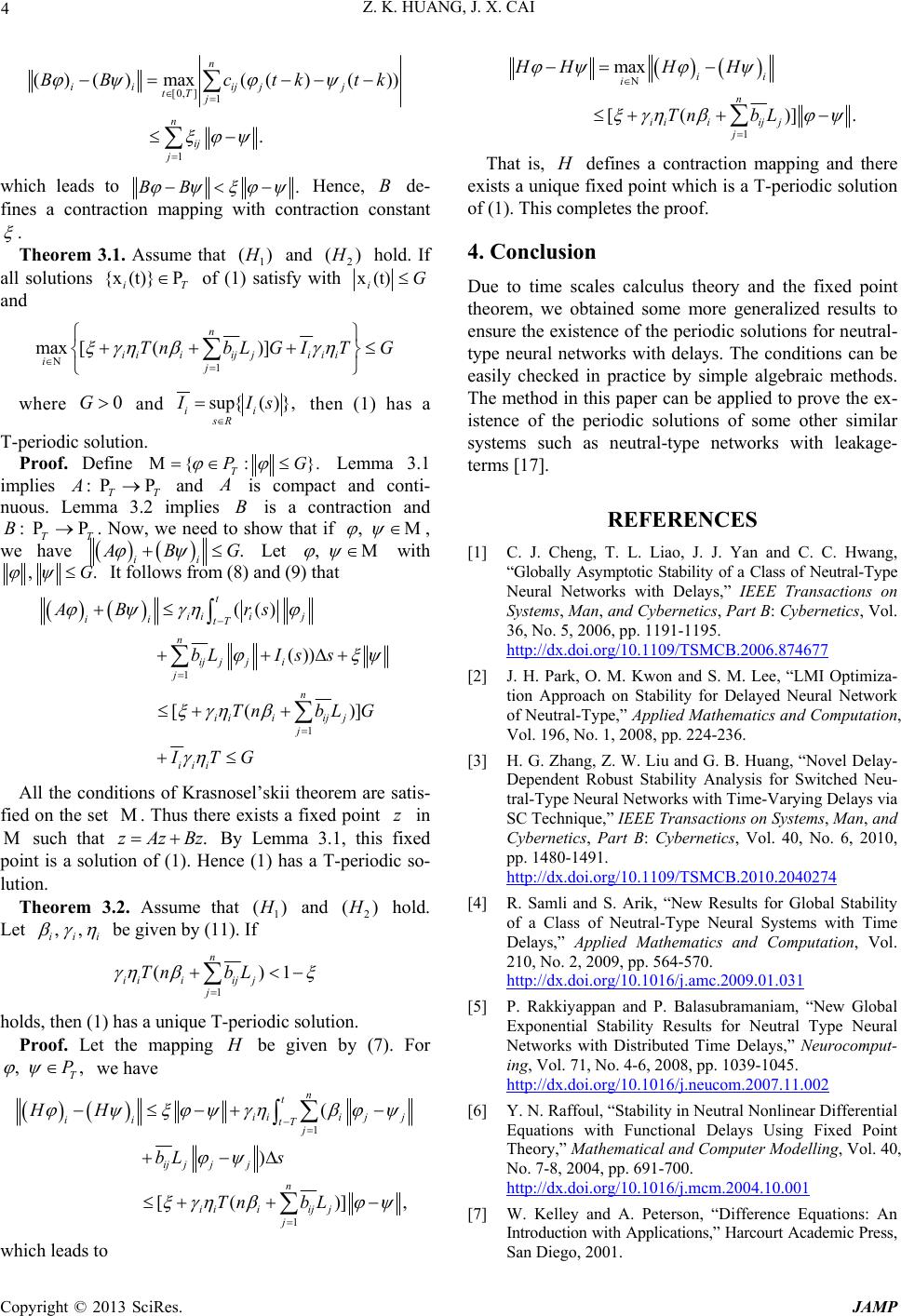 Z. K. HUANG, J. X. CAI Copyright © 2013 SciRes. JAMP 4 [0, ]1 1 ()()max(() ()) . n iiijj j tT j n ij j BBctk tk which leads to .BB Hence, B de- fines a contraction mapping with contraction constant . Theorem 3.1. Assume that 1 () H and 2 () H hold. If all solutions {x (t)}P iT of (1) satisfy with x(t) iG and 1 max [()] n iiiij jiii ij TnbLG ITG wher e 0G and sup{( )}, ii sR I Is then (1) has a T-periodic solution. Proof. Define {:}. T PG Lemma 3.1 implies : PP TT A and A is compact and conti- nuous. Lemma 3.2 implies B is a contraction and : PP TT B. Now, we need to show that if , , we have . ii A BG Let , with ,.G It follows from (8) and (9) that 1 1 (() ()) [()] t ii ij ii tT n ij jji j n iiiij j j iii AB rs bLIss TnbLG ITG All the conditions of Krasnosel’skii theorem are satis- fied on the set . Thus there exists a fixed point z in such that .zAzBz By Lemma 3.1, this fixed point is a solution of (1). Hence (1) has a T-periodic so- lution. Theorem 3.2. Assume that 1 () H and 2 () H hold. Let ,, iii be given by ( 11). If 1 ()1 n iiiij j j Tn bL holds, then (1) has a unique T-periodic solution. Proof. Let the mapping H be given by (7). For , , T P we have 1 1 ( ) [()], n t iii jj ii tTj ij jjj n iiiij j j HH bL s Tn bL which leads to 1 max [()]. ii i n iiiij j j HHH H Tn bL That is, H defines a contraction mapping and there exists a unique fixed point which is a T-periodic solution of (1). This completes the proof. 4. Conclusion Due to time scales calculus theory and the fixed point theorem, we obtained some more generalized results to ensure the existence of the periodic solutions for neutral- type neural networks with delays. The conditions can be easily checked in practice by simple algebraic methods. The method in this paper can be applied to prove the ex- istence of the periodic solutions of some other similar systems such as neutral-type networks with leakage- terms [17]. REFERENCES [1] C. J. Cheng, T. L. Liao, J. J. Yan and C. C. Hwang, “Globally Asymptotic Stability of a Class of Neutral-Type Neural Networks with Delays,” IEEE Transactions on Systems, Man, and Cybernetics, Part B: Cybernetics, Vol. 36, No. 5, 2006, pp. 1191-1195. http://dx.doi.org/10.1109/TSMCB.2006.874677 [2] J. H. Park, O. M. Kwon and S. M. Lee, “LMI Optimiza- tion Approach on Stability for Delayed Neural Network of Neutral-Type,” Applied Mathematics and Computation, Vol. 196, No. 1, 2008, pp. 224-236. [3] H. G. Zhang, Z. W. Liu and G. B. Huang, “Novel Delay- Dependent Robust Stability Analysis for Switched Neu- tral-Type Neural Networks with Time-Varying Delays via SC Technique,” IEEE Transactions on Systems, Man, and Cybernetics, Part B: Cybernetics, Vol. 40, No. 6, 2010, pp. 1480-1491. http://dx.doi.org/10.1109/TSMCB.2010.2040274 [4] R. Samli and S. Arik, “New Results for Global Stability of a Class of Neutral-Type Neural Systems with Time Delays,” Applied Mathematics and Computation, Vol. 210, No. 2, 2009, pp. 564-570. http://dx.doi.org/10.1016/j.amc.2009.01.031 [5] P. Rakkiyappan and P. Balasubramaniam, “New Global Exponential Stability Results for Neutral Type Neural Networks with Distributed Time Delays,” Neurocomput- ing, Vol. 71, No. 4-6, 2008, pp. 1039-1045. http://dx.doi.org/10.1016/j.neucom.2007.11.002 [6] Y. N. Raffoul, “Stability in Neutral Nonlinear Differential Equations with Functional Delays Using Fixed Point Theory,” Mathematical and Computer Modelling, Vol. 40, No. 7-8, 2004, pp. 691-700. http://dx.doi.org/10.1016/j.mcm.2004.10.001 [7] W. Kelley and A. Peterson, “Difference Equations: An Introduction with Applications,” Harcourt Acade mic Press, San Diego, 2001. 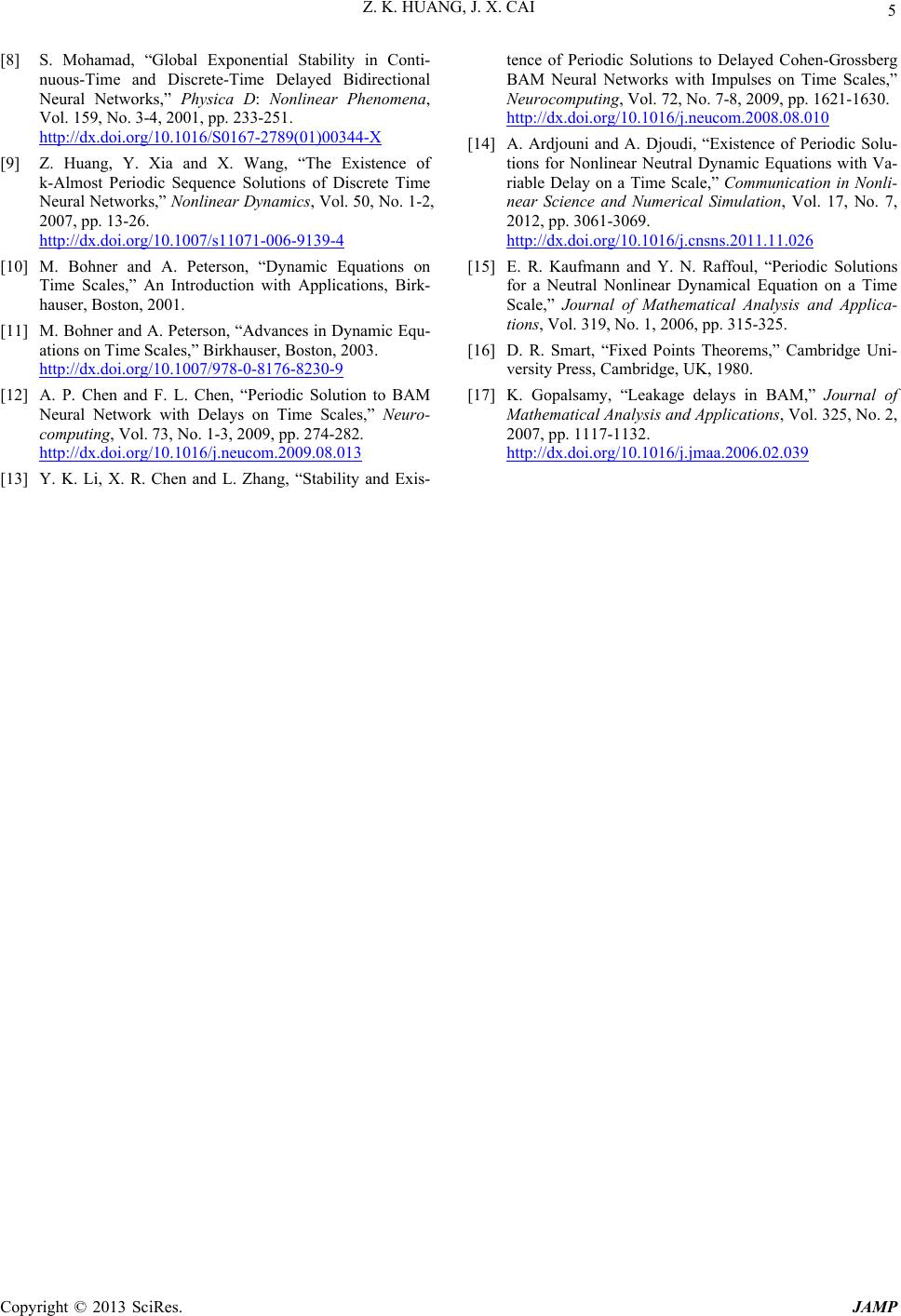 Z. K. HUANG, J. X. CAI Copyright © 2013 SciRes. JAMP 5 [8] S. Mohamad, “Global Exponential Stability in Conti- nuous-Time and Discrete-Time Delayed Bidirectional Neural Networks,” Physica D: Nonlinear Phenomena, Vol. 159, No. 3-4, 2001, pp. 233-251. http://dx.doi.org/10.1016/S0167-2789(01)00344-X [9] Z. Huang, Y. Xia and X. Wang, “The Existence of k-Almost Periodic Sequence Solutions of Discrete Time Neural Networks,” Nonlinear Dynamics, Vol. 50, No. 1-2, 2007, pp. 13-26. http://dx.doi.org/10.1007/s11071-006-9139-4 [10] M. Bohner and A. Peterson, “Dynamic Equations on Time Scales,” An Introduction with Applications, Birk- hauser, Boston, 2001. [11] M. Bohner and A. Peterson, “Advances in Dynamic Equ- ations on Time Scales,” Birkhauser, Boston, 2003. http://dx.doi.org/10.1007/978-0-8176-8230-9 [12] A. P. Chen and F. L. Chen, “Periodic Solution to BAM Neural Network with Delays on Time Scales,” Neuro- computing, Vol. 73, No. 1-3, 2009, pp. 274-282. http://dx.doi.org/10.1016/j.neucom.2009.08.013 [13] Y. K. Li, X. R. Chen and L. Zhang, “Stability and Exis- tence of Periodic Solutions to Delayed Cohen-Grossberg BAM Neural Networks with Impulses on Time Scales,” Neurocomputing, Vol. 72, No. 7-8, 2009, pp. 1621-1630. http://dx.doi.org/10.1016/j.neucom.2008.08.010 [14] A. Ardjouni and A. Djoudi, “Existence of Periodic Solu- tions for Nonlinear Neutral Dynamic Equations with Va- riable Delay on a Time Scale,” Communication in Nonli- near Science and Numerical Simulation, Vol. 17, No. 7, 2012, pp. 3061-3069. http://dx.doi.org/10.1016/j.cnsns.2011.11.026 [15] E. R. Kaufmann and Y. N. Raffoul, “Periodic Solutions for a Neutral Nonlinear Dynamical Equation on a Time Scale,” Journal of Mathematical Analysis and Applica- tions, Vol. 319, No. 1, 2006, pp. 315-325. [16] D. R. Smart, “Fixed Points Theorems,” Cambridge Uni- versity Press, Cambridge, UK, 1980. [17] K. Gopalsamy, “Leakage delays in BAM,” Journal of Mathematical Analysis and Applications, Vol. 325, No. 2, 2007, pp. 1117-1132. http://dx.doi.org/10.1016/j.jmaa.2006.02.039 |

